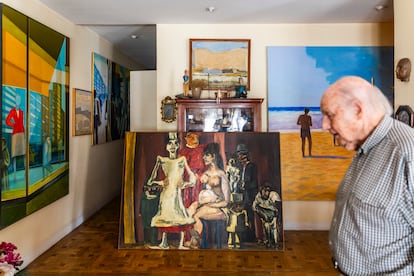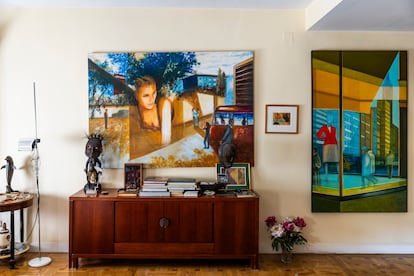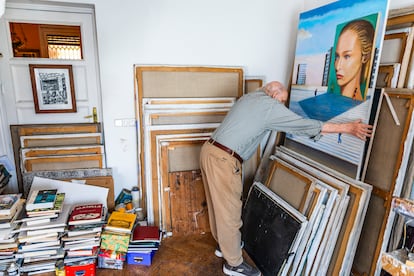Joaquín Pacheco (Madrid, 91 years) is part of an extensive group of artists (Juan Giraralt, Agustín Celis) who forged their work outside Spain during the years of the dictatorship. All of them knew how to take advantage of public or private aid that allowed them to travel to Europe. In the fifty and sixty, Paris was the destiny dreamed by those artists. In 1961, a young Joaquín Pacheco was able to settle in the French capital thanks to a Scholarship of the March Foundation. He was 27 years old, a rudimentary French level and a attic on the rue des Écoles who had rented at him at the price of friends. It was for a month and stayed for 20 years in a city with 140 galleries and more than 22,000 registered artists who lived his last times as the world’s world capital, before being displaced by New York.
The life and work of this teacher of the new figuration stars Joaquín Pacheco, Painting and Wordthe last documentary of the filmmaker Félix Cábez (Madrid, 64 years old). The film is already part of the Caixaforum catalog and has been projected in Valencia. Cábez says that the documentary’s proposal started from a group of collectors determined to publicize an artist that the general public has not had the possibility of contemplating despite being present in the collections of the Bank of Spain or Queen Sofía. “We have had few media (about 25,000 euros) but the artist’s personality dazzles those who know him,” says the director.
The house of Joaquín Pacheco is on Alcalá Street in Madrid, very close to the Plaza de Las Ventas in which being very child his love for the bulls. The wide housing is also his study and from the hall you can see how his work occupies all the walls and is stacked in any hole with the ability to pile up to a dozen canvases. All the paintings are his, except for two portraits that two of his best friends have dedicated to him: El Roto and Hernán Cortés Moreno.
In the midst of that pictorial jungle, Joaquín Pacheco moves with ease and perfect knowledge of each of the paintings. He claims to have them all inventoried. Both these and the ones you keep in the warehouse. The windows, beach scenes or large portraits of different formats give the house an air of a museum crowned by a study chaired by a easel and a sculptural palette of acrylic paintings. Among images that the characters of Hopper, Vermeer or Chirico remember, Pacheco continues to paint every day. Less time as you would like. Before he worked from 9 to 3, but Carmen’s disease, his wife, requires a lot of dedication. The conversation with this very cultured man, who retains intact the memory of the lived, is sometimes difficult to redirect for the amount of details that are threaded in his memories, but as he says, sometimes the important thing is outside the battlefield.
Because of starting at the beginning, Joaquín Pacheco explains that he is the son of a middle -class family, born on Goya Street, son of a fiscal father and mother dedicated to home care. Since five years, he remembers, his father took him with his brother every Sunday to the Prado Museum. The love and gratitude you keep for the museum are immeasurable. To the point that when he has had personal problems, anguish was diluted when walking in front of Velázquez, Goya or Solana. The museum is known and there continues to go every time he has a while.
Manolete
The circus and bulls, themes of their first paintings, are images that start from when I had not turned 10. “We had a babysitter, Eugenia, who loved the bulls and sneaked into the Plaza de Las Ventas because it was one of those women who always know someone. Thanks to her I could see Manolete. Thanks to her too, welcome, who were neighbors, left us their hoods. Interest in the circus two aunts were occupied that were very fun.”

The pleasure of painting also came as a child, at the College of the Sacred Hearts where he taught Luis García-Echoa drawing, artist of the Madrid School. “He encouraged me very much. I remember him very affectionately, as well as the professor of literature, a Chilean priest, who made us read Rimbaud Oa Baudelaire and his Flowers of evil. This professor suddenly said goodbye to school and then we knew that he had flown to Valparaíso to teach Pinochet communism. ”
Pressing by his father, who was not clear about painting, Pacheco studied a few years of philosophy and law. He kept painting, but in no way he wanted to enroll in the School of Fine Arts of San Fernando because the figuration that was taught did not interest him.
THE PARIS OF THE SIXTY
Eager to meet world and the little money from the scholarship, Pacheco fell dazzled in a Paris that smelled of painting, literature and music everywhere. The windows that had begun to paint in Madrid were shown plethoric and loaded with suggestions of the city. He was clear that he stayed and survived working in black, like almost all his colleagues in that Paris in which Picasso was already a god.
Remember that a Spanish friend recommended him to take care of the shop windows of an antiquarian central. With great grace he says that he was placing comfortable in the business showcase when under the snow he recognized a mythical march with which all painters wanted to work. It was Katia Granoff, a Jewish gallery owner of Russian origin who carried the representation of artists such as Matisse and had been done with the last 40 Nenruars of Monet. Here Pacheco adds that Granoff had achieved the monets Thanks to the vice of playing the letters of the artist’s son: “In a trick he lost the house with everything inside, including The water lilies. ” That exotic encounter under the snow with Mrs. Granoff meant signing with her and leaving the subsistence work to which she would have been forced.
In Paris she married her great friend Ana Vázquez de Parga and then separated, although they always kept friendship. There he had his daughter Sara. He dealt with Spanish intellectuals of exile and others who had moved voluntarily. Every Friday José Bergamín had dinner at his house. Díaz Canela or the sculptor Baltasar Lobo also passed there. “Wolf was a good person I have met in life. Thanks to him I was about to meet Picasso. He called me to invite me to the exhibition of The painter and the model “, Pacheco points. But Picasso did not appear because he had a flu and in 1975 Pacheco left Paris fed up with his disagreements with André Malraux, who put obstacles so that Picasso’s children had a French passport. “Then he concealed, but Malraux despised Picasso.”

In the documentary, Pacheco speaks of his lively Parisian life and his meetings with Ernest Hemingway, Alberto Giacometti or Janis Joplin who heard singing in an overwhelming concert. On his return to the Spain of the eighties, in the middle of the transition, it is one of the artists who do not find accommodation. He comes to expose in the bass of the National Library or in his galleries, Biosca and the collector, but the focus is elsewhere. “The only thing that seems to import is the foreign movement and artists. María Corral and Carmen Giménez were interested in my paintings, but I have not come to have an institutional exhibition as I think I would deserve.”
Nor has Joaquín Pacheco been recognized with one of the great official awards. He blames it to his lonely path within a market that is relentless by issuing orders. He has always sold, but now he feels that fashions go for other paths. “If you do not obey the slogans of the market, they expel you, but nothing will stop doing what I consider to be art. I am not interested in the merchandise,” he says while he continues to renovate anecdotes and retailing his paintings.

